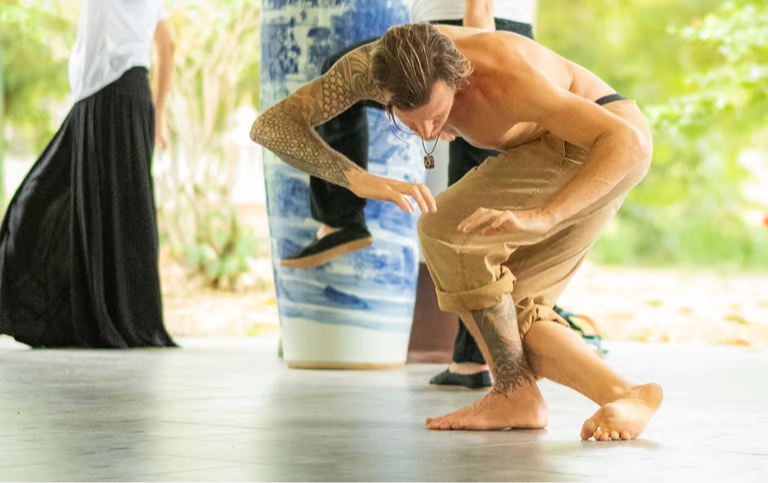
Calisthenics athletes: why Qigong is the number one answer for better mobility
Mar 09, 2019Equal parts dynamic power, control, and grace, calisthenics are the epitome of physical and mental self-mastery. You already know you need strength to perfect calisthenics exercises. But did you know your progress is also directly linked to your ability to freely move and position the joints of your body? By increasing ROM, enhancing body awareness, and promoting active recovery, a well-rounded mobility training program can further your calisthenics performance potential, prevent injuries, and inspire your workout creativity.

Why should calisthenics athletes do mobility training?
Mobility describes your ability to actively move your joints through their full range of motion (ROM) without pain, restriction, or compensatory patterns. A compensatory pattern can develop when you lack mobility in any given joint and then use a different muscle or movement pattern to complete the movement. (For example, limited hip mobility may lead you to hyperextend your lumbar spine while squatting). While this may not seem initially problematic, ignoring mobility restrictions while increasing the intensity of your calisthenics practice can create muscle imbalances, limit your gains in strength and control, and heighten your risk for injury.
Mobility limits and compensatory patterns can also develop when you exclusively and repeatedly moving the joints through the same ROM and plane of motion, which can place negative stress on your joints and make you more vulnerable to the much dreaded overuse injuries. While calisthenics develop numerous movement capacities in the sagittal and frontal planes, the rotational movements found in the transverse plane are largely underrepresented.
Rotation is a functional movement ability that is essential to the normal activities of daily living and physical activities. It’s also a key element of any well-rounded mobility training program--and for good reason. Intentionally practicing rotation can help provide you with the supple stability you need to improve balance, enhance spatial awareness (proprioception), prevent injury, reduce feelings of muscle tension, and move more efficiently.
When should I add mobility training?
Mobility is the foundation for developing stability, increasing strength, and improving your movement techniques. By taking you outside the box of your normal movement patterns fitness routines, mobility training helps you develop control in different ROMs, develop control in under-utilised muscle groups, prevent chronic and acute injuries, and ultimately help you become a better master of your bodyweight. For calisthenics athletes, here’s when you can get the most of your mobility training.
Warm-up
Practicing mobilisation exercises for 15-45 minutes before your workout allows you to sufficiently warm up your musculoskeletal and respiratory systems without fatiguing your muscles.
Active recovery
Active recovery is low-intensity exercise that allows your body and mind to recover after high intensity exercise or strength training. In addition to effectively alleviating your muscles, joints, and connective tissues of the stress they endured, adding active recovery to your routine 1-2 days a week can help promote circulation, reduce lactic acid buildup, and improve muscle growth and strength.

Qigong for Calisthenics Athletes
Though over 5,000 years old, Qigong shares many qualities with calisthenics. Qigong is a comprehensive health system that incorporates body weight exercises to develop functional mobility, supple strength, core stability, discipline, focus, and self-mastery. Unlike generic forms of mobility workouts, Qigong’s mind-body system helps to develop skills that directly enhance a calisthenics athlete’s physical and mental fortitude.
Like calisthenics, Qigong is a whole-body system that develops movement patterns that are directly transferable to functional human movements. Inspired by animal forms and dragon movements, 5 Animal Qigong and 5 Element Qigong use bodyweight exercises, deep squats and lunges, shoulder mobilisation, balancing, and spinal rotation to develop dynamic strength, functional mobility, embodied awareness, and respiratory control.
Qigong exercises are innately three-dimensional and engage the sagittal, frontal, and transverse planes to develop and refine proprioception, balance, control, and grace--skills that are essential for advancing in calisthenics. Most Qigong exercises also generate eccentric muscle contractions, which can promote gains in functional flexibility and connective tissue (tendon and ligament) strength.
Try these Qigong exercises in your next workout
Deer peeks its head

Bending forward without arching the back, and focusing on your palm in front of you, extend your neck gently then bring it back to normal three times. This exercise from the 5 Animals Qigong ebook aids athletes who suffer from neck strain after a calisthenics workout, this exercise gently stretches, strengthens, and lengthens your neck.
Tiger hunts for prey

This exercise from the 5 Animals Qigong ebook is extremely effective for a full-body stretch. It involves twisting the torso, which opens up the hips deeply and lengthens the body. The twist is activated in the feet, and can be felt throughout the whole body, stretching the upper torso, neck, shoulders, and arms. This dynamic cross-stretch goes all the way up the back of the body, while your lower leg muscles are activated while stabilising the movement.
White Tiger Qigong
White Tiger Qigong is an artful balance of mobility, stability, strength, and proper breathing mechanics. As Master Trainer Tevia Feng tells his students, “flow like water, dance like fire.” In other words, the body must be able to move as freely and fluidly as water while possessing the capacity to move with explosive ferocity. Equally, the mind needs to be trained to adapt to change and the perseverance to face and overcome challenges.
In both calisthenics and Qigong, mobility is the foundation of strength, and practice is the root of progress. To increase your mobility and advance your calisthenics capabilities, visit our blog or dive into our online courses and e-books.



